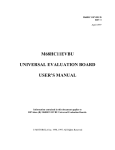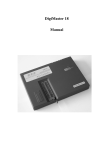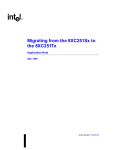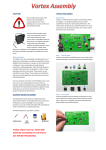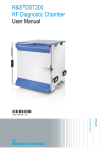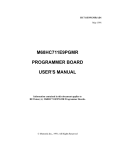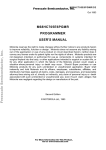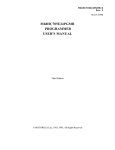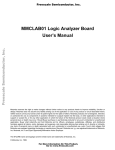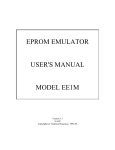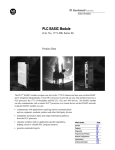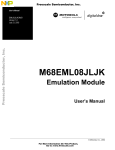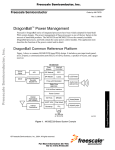Download m68hc705f32pgmr programmer user`s manual
Transcript
Freescale Semiconductor, Inc. M68HC705F32PGMR/D Rev. 2 March 1995 Freescale Semiconductor, Inc... M68HC705F32PGMR PROGRAMMER USER'S MANUAL Third Edition © MOTOROLA Ltd., 1995; All Rights Reserved For More Information On This Product, Go to: www.freescale.com Freescale Semiconductor, Inc... Freescale Semiconductor, Inc. Motorola reserves the right to make changes without further notice to any products herein to improve reliability, function, or design. Motorola does not assume any liability arising out of the application or use of any product or circuit described herein; neither does it convey any license under its patent rights nor the rights of others. Motorola products are not designed, intended, or authorized for use as components in systems intended for surgical implant into the body, or other application in which the failure of the Motorola product could create a situation where personal injury or death may occur. Should Buyer purchase or use Motorola products for any such unintended or unauthorized application, Buyer shall indemnify and hold Motorola and its officers, employees, subsidiaries, affiliates, and distributors harmless against all claims, costs, damages, and expenses, and reasonable attorney fees arising out of, directly or indirectly, any claim of personal injury or death associated with such unintended or unauthorized use, even if such claim alleges that Motorola was negligent regarding the design or manufacture of the part. Motorola and the Motorola logo are registered trademarks of Motorola Inc. Motorola Inc. is an Equal Opportunity/Affirmative Action Employer. For More Information On This Product, Go to: www.freescale.com Freescale Semiconductor, Inc. Table of Contents 1. INTRODUCTION............................................................................................1-5 1.1 BOARD LAYOUT AND DESCRIPTION...............................................................................................1-6 1.2 PROGRAMMING MODES.................................................................................................................1-6 2. PARALLEL MODE.........................................................................................2-7 2.1 68HC705F32 PARALLEL PROGRAMMING MODE............................................................................2-7 2.1.1 Programming Procedure.................................................................................................................2-7 2.1.2 Notes on the Programming Operation..............................................................................................2-7 2.2 68HC705F32 PARALLEL VERIFICATION MODE..............................................................................2-8 2.2.1 Programming Procedure.................................................................................................................2-8 2.2.2 Notes on the Verification Operation.................................................................................................2-8 Freescale Semiconductor, Inc... 3. SERIAL MODE..............................................................................................3-9 3.1 MC68HC705F32 SERIAL PROGRAMMING MODE............................................................................3-9 3.1.1 Software Requirements..................................................................................................................3-9 3.1.2 Hardware Requirements..................................................................................................................3-9 3.1.3 Programming Procedure.................................................................................................................3-9 3.1.4 Notes on the Programming Operation.............................................................................................3-10 APPENDIX A . . . . . . . . . . . . . . . . . . . . . . . . . . . . . . . . . . . . . . . . . . . . . . . . . . . . . . . . . . . . . . . . . . . . . . . . . . . . . . . . . . . . . . . . . . . . . . . . . A - 1 0 A.1 SERIAL PROGRAMMING CABLE...................................................................................................A-11 For More Information On This Product, Go to: www.freescale.com Freescale Semiconductor, Inc... Freescale Semiconductor, Inc. This page intentionally left blank For More Information On This Product, Go to: www.freescale.com Freescale Semiconductor, Inc. CHAPTER 1. INTRODUCTION This manual describes the procedure used to program and verify the MC68HC705F32 microcontroller (MCU) on the M68HC705F32PGMR. All that is required to program the MCU is the PGMR, +5 volt and VPP dc power supply, and a pre-programmed EPROM (parallel mode). Freescale Semiconductor, Inc... The PGMR supports 100 pin thin quad flat pack (TQFP) and 80 pin thin quad flat pack (TQFP) MCU programming by provision of two adapters. S1 controls power to the MCU Install power leads at P1 S2 controls the MCU RESET S3, S4 & JP2 select modes P1 SKT1 S1 S2 S3 S4 JP1 P2 JP2 Connect serial cable to P2 SKT1 contains the program EPROM JP1 selects mode Install the appropriate socket adapter Figure 1.1 M68HC705F32PGMR Layout For More Information On This Product, Go to: www.freescale.com Freescale Semiconductor, Inc. 1.1 BOARD LAYOUT AND DESCRIPTION Figure 1.1 shows the layout of the PGMR. As shown in the figure there are various controls, connectors and sockets that provide the ability to configure the board to specific MCU programming requirements. Freescale Semiconductor, Inc... For the board to function correctly you must supply the required power to the board at connector P1. +5V dc @ 100mA and ground lines are required. In addition a VPP power supply is needed to perform the programming. The value of this supply may vary between MCUs, please refer to this manual and the device data book for further information. Switches S1 and S2 control the activity of the PGMR. S1 is a simple on/off switch that applies power to the MCU device when on. Never remove or install an MCU when the S1 switch is in the ON position. S2 control the MCU reset line. Programming cannot take place while the part is in reset mode. Two jumper headers (JP1 and JP2) and two switches (S3 and S4) configure the PGMR for the particular MCU and function in use. They select between different EPROM sizes, and modes. The following sections describe how to configure these jumpers for your programming requirements. Lastly, socket U4 allows for the installation of the master EPROM. Socket U5 allows the installation of two adapter boards (provided). Each adapter board allows the programming of a single MCU. One adapter board supports the 80 TQFP package and one the 100 TQFP package. IMPORTANT NOTE Ensure the package adapters boards are orientated correctly onto the main PGMR board. Always ensure that the devices are orientated correctly into their respective sockets. 1.2 PROGRAMMING MODES The PGMR supports two modes of programming. In parallel mode the user programs the MCU by copying the contents of an EPROM in U4. See chapter 2 for instructions. In serial mode the user communicates directly with the MCU via a serial cable and connector P2. See Chapter 3 for instructions. For More Information On This Product, Go to: www.freescale.com Freescale Semiconductor, Inc. CHAPTER 2. PARALLEL MODE This programming mode copies a user program contained in an external EPROM, into the internal PROM (OTPROM/EPROM/EEPROM) of the MC68HC705F32 MCU. 2.1 68HC705F32 PARALLEL PROGRAMMING MODE Freescale Semiconductor, Inc... Settings required: JP1 S3 S1 U4 256 if 27C256 installed JP2 512 if 27C512 installed OFF S4 OFF S2 27C256 or 27C512 EPROM Installed Parallel OFF IN 2.1.1 Programming Procedure a) Apply power to the PGMR board. b) Insert the 705F32 MCU device into the PGMR. c) Set S1 to ON. d) Set S2 to OUT. The selected programming routine is then executed. e) Once the programming is complete (see section 2.1.2), set S2 to IN and S1 to OFF. You may now remove the MCU from the socket. 2.1.2 Notes on the Programming Operation In the program MCU PROM routine, the contents of the external 32K EPROM are copied into the MCU PROM areas of the applicable device. There is a direct correlation of addresses between the two devices. Non-MCU PROM addresses are ignored so data contained in those areas are not accessed. Unprogrammed external EPROM address locations should contain $00 to speed up the programming operation. During the programming routine, the PROGRAM LED D2 is illuminated. At the end of the programming routine, D2 is turned off, and the verification routine is entered. If the contents of the MCU PROM and external EPROM exactly match, then the VERIFY LED D3 is illuminated. During the verification routine, all locations are compared to the data residing in external EPROM. The verification routine will stop if a discrepancy has been detected and the error address location will be placed on the external memory address bus. For More Information On This Product, Go to: www.freescale.com Freescale Semiconductor, Inc. 2.2 68HC705F32 PARALLEL VERIFICATION MODE Settings required: JP1 256 if 27C256 installed JP2 512 if 27C512 installed ON S4 OFF S2 27C256 or 27C512 EPROM Installed S3 S1 U4 Parallel ON IN 2.2.1 Programming Procedure Freescale Semiconductor, Inc... a) Apply power to the PGMR board. b) Insert the 705F32 MCU device into the PGMR. c) Set S1 to ON. d) Set S2 to OUT. The selected verification routine is then executed. e) Once the programming is complete (see section 2.2.2), set S2 to IN and S1 to OFF. You may now remove the MCU from the socket. 2.2.2 Notes on the Verification Operation The verify MCU PROM contents routine is normally entered automatically after the MCU PROM is programmed. Direct entry of this mode will cause the MCU PROM contents to be compared to the external EPROM contents residing at the same address locations. Both D2 and D3 LEDs are turned off at this time until verification is completed. Upon completion of the verification routine (every location verified) the VERIFIED LED D3 is illuminated. If D3 does not illuminate, a discrepancy has been detected and the error address location will be placed on the external memory address bus. NOTE MCU PROM blank checking can be accomplished by placing $00 into the external EPROM (SKT U4) and following the above verify MCU PROM routine. For More Information On This Product, Go to: www.freescale.com Freescale Semiconductor, Inc. CHAPTER 3. SERIAL MODE This programming mode allows the user to download an S-record format file directly into the MCU by using an external computer system. The following sections describe the procedure taken to program each MCU type. Freescale Semiconductor, Inc... 3.1 MC68HC705F32 SERIAL PROGRAMMING MODE Settings required: JP1 S3 S1 U4 256 OFF OFF no EPROM installed JP2 S4 S2 P2 Serial OFF IN Serial cable to PC 3.1.1 Software Requirements SERPGM.EXE Revision V0.60. 3.1.2 Hardware Requirements The hardware requirements to run the SERPGM program are as follows: 1 x IBM® PC Compatible Personal Computer 1 x Serial Port 1 x Connecting Cable 3.1.3 Programming Procedure a) Apply power to the PGMR board. b) Insert the 705F32 MCU device into the PGMR. c) Set S1 to ON. d) Set S2 to OUT. e) At the PC prompt type SERPGM f) Select either 1 for EPROM programming or 2 for EEPROM programming. g) Enter the name of the S-record whose contents you wish to copy into the internal memory. h) The program displays the progress of the programming procedure. Any errors are flagged to the screen. You may terminate the programming procedure at any time by typing (CTRL) D. i) Once the programming is complete (see section 3.1.4), set S2 to IN and S1 to OFF. You may now remove the MCU from the socket. For More Information On This Product, Go to: www.freescale.com Freescale Semiconductor, Inc. 3.1.4 Notes on the Programming Operation The sequence of events noted above must be followed or the MCU will not program. Errors in programming EPROM are normally caused by an incorrect EPROM VPP value. Take care not to exceed the recommended value. Freescale Semiconductor, Inc... If the program is unable to communicate with the MCU the screen remains blank rather than displaying memory program progress. For More Information On This Product, Go to: www.freescale.com Freescale Semiconductor, Inc. APPENDIX A A.1 SERIAL PROGRAMMING CABLE The following pages give details of a serial programming cable . If a nine way connector is used the signals must be mapped correctly. 25 "D" SUBMINIATURE MALE(PIN) CONNECTORPART #'S: 25 "D" SUBMINIATURE FEMALE(SOCKET) CONNECTORPART #'S: 1. CIRCUIT ASSEMBLY CORP #CA•25•SMD•P 1. CIRCUIT ASSEMBLY CORP #CA•25•SMD•S 2. ITT CANNON #DBSP-B25P 2. ITT CANNON #DBSP-B25S 3. ANSLEY #609•25P 3. ANSLEY #609•25S 4. WINCHESTER #49•1125P 4. WINCHESTER #49•1125S 25 PIN "D" SUBMINIATURE CONNECTOR 1 2 14 3 15 4 16 5 17 6 18 7 19 8 20 9 21 10 22 11 23 12 24 13 25 1 2 14 3 15 4 16 5 17 6 18 7 19 DCD NOT CONNECTED DTR SIGNAL GND DSR CTS RTS RXD TXD RED WIRE GND Freescale Semiconductor, Inc... 20 OR 25 CONDUCTOR FLAT RIBBON CABLE 3M #3365-20 OR 3M #3365-25 8 20 9 21 10 22 11 23 12 24 13 25 25 PIN "D" SUBMINIATURE CONNECTOR FIGURE A-1. PGMR/Host Computer Cable Assembly Diagram For More Information On This Product, Go to: www.freescale.com Freescale Semiconductor, Inc. A Hayes compatible modem cable, purchased from a local computer store, can be used to connect the PGMR to the host computer. The PGMR is wired as data communication equipment (DCE) whereas a terminal and most serial modem ports on host computers are wired as data terminal equipment (DTE). This lets a straightthrough cable be used for most set-ups. If a different type of cable is used to connect the PGMR to the host computer, a null modem adapter (shown below) may be required to match the cable to the EVS terminal port connector. Freescale Semiconductor, Inc... A null modem adapter reverses the roles of various data and control signals to make a DTE device appear as a DCE device, or vice versa. DB-25S DB-25P GND 1 1 GND TXD 2 2 TXD RXD 3 3 RXD RTS 4 4 RTS CTS 5 5 CTS DSR 6 6 DSR 7 7 SIG-GND DCD 8 8 DCD DTR 20 20 DTR SIG-GND FIGURE A-2 Null Modem Adapter For More Information On This Product, Go to: www.freescale.com












